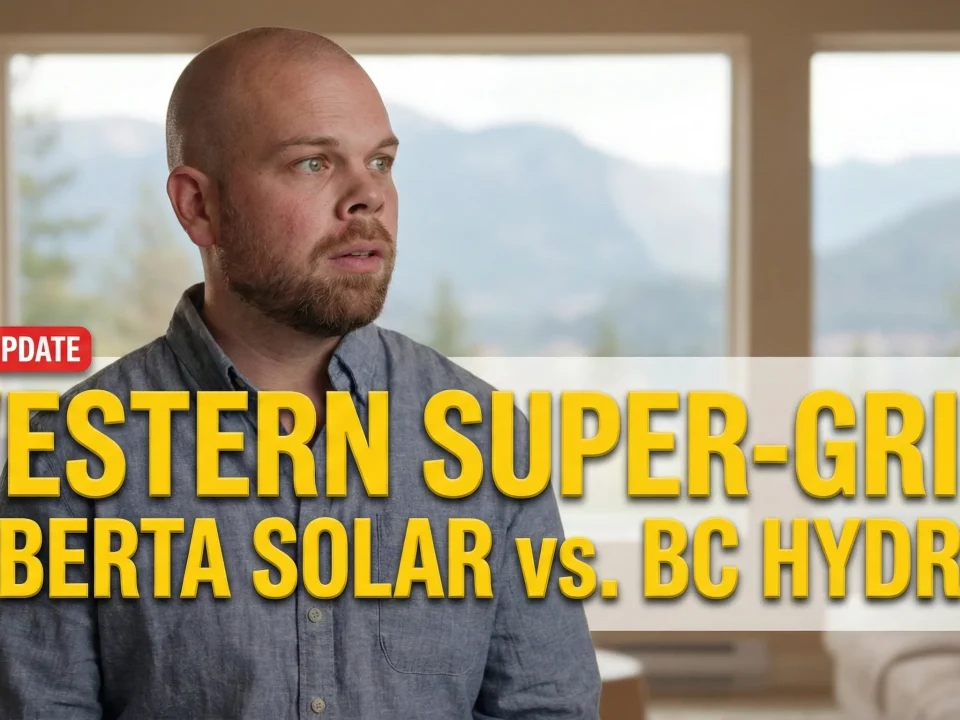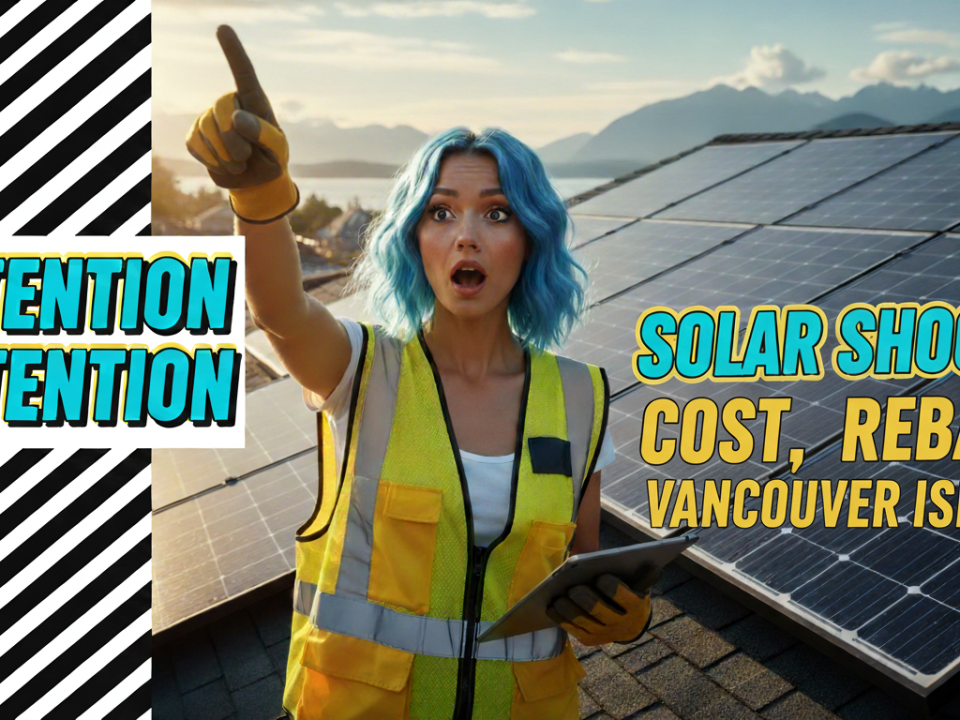
Solar Panels Yukon Guide 2025 + Calculator
August 7, 2025
Solar Panel Saskatchewan Cost Guide 2025
August 7, 2025What makes Alberta an ideal location for solar panels?
It sounds wrong, doesn’t it? Alberta, the province known for its cold winters, being a hotspot for solar energy. But the numbers don’t lie. The key factor for solar power isn’t heat; it’s solar irradiance—basically, how much sunlight hits a surface. And Alberta gets a lot of it.
Cities like Calgary and Edmonton receive more sun exposure than almost any other major city in Canada. We’re talking about 1,200 to 1,400 peak sun hours per year. To put that in perspective, that’s more than Rio de Janeiro. The long summer days and clear, cold winter skies create perfect conditions for solar panels to generate electricity efficiently. Cold temperatures actually improve a solar panel’s performance, a fact many people find surprising.

How has the solar industry evolved in Alberta by 2025?
The solar scene in Alberta is a bit of a two-speed story right now. On one side, residential solar is booming. Homeowners are tired of high and unpredictable energy bills, and they’re taking action. The growth in micro-generation (that’s the official term for small-scale systems like yours) has been steady. According to the Alberta Electric System Operator (AESO), the number of homes and small businesses with their own solar array continues to climb year after year.
On the other side, the massive, utility-scale solar projects have hit some bumps. A provincial moratorium in 2023 and new land-use rules in 2024 have made investors nervous, slowing down the development of large solar farms. For you, the homeowner, this doesn’t change much about your ability to install solar panels, but it’s part of the bigger picture of renewable energy in the province.

Understanding Solar Panel Technology
What are the latest advancements in solar panel technology?
Solar technology is always improving. The solar modules you can get today are more efficient and durable than ever. Key advancements include:
- PERC (Passivated Emitter and Rear Cell) technology: This is now standard in most high-quality panels. It adds a layer to the back of the solar cells to capture more light, boosting efficiency, especially in low-light conditions like early morning or on cloudy days.
- Bifacial Panels: These panels can capture sunlight from both sides. When installed on a light-coloured roof or a ground mount, the reflected light (known as albedo) can increase energy production by up to 15-20%.
- Half-Cut Cells: Instead of one large cell, the panel is made of smaller, half-sized cells. This reduces electrical resistance, which means less power is lost as heat, making the panel more efficient and reliable.

How do solar panels work in Alberta’s climate?
This is the number one question I get. People see snow and think it’s a dealbreaker. It’s not.
First, solar panels love the cold. Unlike most electronics, their efficiency increases as the temperature drops. A crisp, sunny winter day is a fantastic day for solar production.
What about snow?
- Shedding: Panels are smooth and installed at an angle, so light, dry snow often slides right off.
- Melting: Even a small amount of sunlight hitting a dark panel will cause it to warm up, melting the snow around the edges and helping the rest slide off.
- Reflection: A layer of snow on the ground can actually help bifacial panels by reflecting more light onto their undersides.
Studies from institutions like the Northern Alberta Institute of Technology (NAIT) have shown that the annual energy loss from snow cover is typically only around 3-5%. It’s a factor, but a very small one. Hail is a real concern, but modern panels are built to handle it. They are rated to withstand hailstones up to an inch in diameter. Your home insurance should cover the solar array, just in case.
What are the best types of solar panels for Alberta?
You’ll mainly see two types of solar panels offered for residential solar installations. Here’s a quick breakdown:
| Panel Type | Description | Pros for Alberta | Cons for Alberta |
|---|---|---|---|
| Monocrystalline | Made from a single, pure silicon crystal. They have a uniform black appearance. | Higher efficiency (18-23%), performs better in low light, more space-efficient (fewer panels needed). | Higher initial cost. |
| Polycrystalline | Made from multiple silicon fragments melted together. They have a blue, speckled look. | Lower cost to install solar panels. | Lower efficiency (15-18%), requires more roof space for the same output. |
My take: For most Alberta homeowners, monocrystalline panels are the better investment. Their higher efficiency means you can generate more power from a limited roof space, and their superior performance on cloudy days gives you an edge in our variable climate. The slightly higher installation cost is usually offset by greater energy production over the system’s life.

Benefits of Installing Solar Panels in Alberta
What are the environmental benefits of solar panels?
Let’s start with the obvious. Using the power of the sun to power your home is a direct way to reduce your carbon footprint. The average Alberta home uses about 7,200 kWh of electricity per year. By generating that power with a solar energy system, you prevent several tonnes of CO2 from entering the atmosphere annually. It’s a tangible contribution to cleaner air and a more sustainable energy future for the province.

How can solar panels reduce your energy bills?
This is where going solar really hits home. When your solar panels generate electricity, your house uses that power first. You only pull from the grid if your energy needs exceed what your panels are producing (like at night).
During the long summer days, you’ll likely produce far more electricity than you use. This excess energy is sent back to the grid, and thanks to Alberta’s net metering (often called micro-generation), you get credited for every kilowatt-hour you export. These credits act like money in the bank on your power bill, directly paying for any electricity you need to pull from the grid at night or in the winter. Many homeowners find their bills are zero, or even negative, during the summer months.

What incentives and rebates are available for solar installations?
The financial support for switching to solar in Alberta is a bit different from other provinces. There isn’t a single, big provincial rebate. Instead, the support comes from federal and municipal levels.
- Canada Greener Homes Loan: This is the main federal program. It offers an interest-free loan of up to $40,000 with a 10-year repayment term. This is a game-changer because it can cover the entire installation cost, meaning you can go solar with no money down. You can find the full details on the Natural Resources Canada website.
- Clean Energy Improvement Program (CEIP): This program is offered by individual municipalities, not the province. It allows you to finance your solar panel investment through your property tax bill over a long term (up to 25 years) at a low interest rate. Cities like Edmonton, Calgary, and Lethbridge participate. Some, like Spruce Grove, even add a local rebate on top.

Solar Panel Installation Process
How to choose a reliable solar panel installer in Alberta?
Choosing the right solar installer is the most critical step. A good installation is the key to a system that performs well for 25+ years.
Tip for choosing an installer:
- Check Certifications: Look for companies with installers certified by organizations like Solar Alberta or the Canadian Solar Industries Association (CanSIA).
- Get Multiple Quotes: Talk to at least three different solar companies. This gives you a feel for the market price and different approaches. Don’t just go for the cheapest; compare the equipment they propose and the warranties they offer.
- Read Reviews: Look at reviews from local customers. How did the company handle the process from start to finish?
- Ask About Timelines: Be direct and ask about current timelines for permits and grid connection. A good installer will be honest about potential delays.

What is the step-by-step process for installing solar panels?
- Consultation & Home Energy Audit: A solar consultant will assess your home’s roof, electrical panel, and your annual energy consumption to design the right-sized solar power system. This often involves a home energy audit.
- Quote & Financing: You’ll receive a detailed quote. This is when you apply for financing like the Greener Homes Loan or CEIP.
- Permits & Approvals: The solar installer handles all the paperwork, including electrical permits and getting approval from your utility (like ENMAX, EPCOR, or FortisAlberta) to connect to the grid.
- Installation: The physical installation of the solar array and inverter usually takes just 2-3 days.
- Inspection & Grid Connection: A municipal inspector will sign off on the work. Then, the utility gives the final permission to “flip the switch.” This final step has recently been subject to delays, which is a real pain point for some homeowners.

I had a client in a rural area outside Edmonton last year. The panels were on his roof in May, looking great. But due to a backlog, he couldn’t get his final connection approval until late August. He was frustrated, and I don’t blame him. It’s a problem the industry and utilities need to solve, but it’s the reality on the ground right now.
What’s the Real Cost of Solar Panels in Alberta?
What is the average cost of solar panels in Alberta in 2025?
Let’s break down the numbers. The cost of installing solar is usually measured in dollars per watt. In Alberta, you can expect the installation cost to be between $2.60 and $3.27 per watt.
Here’s a table with the key financial data for a typical residential solar project:
| Parameter | Value | Notes |
|---|---|---|
| Average Price Per Watt | $2.94 | This is a good baseline for a quality installation. |
| Average System Size | 7.5 kW | Sized to cover the electricity needs of a typical Alberta home. |
| Gross Installation Cost | ~$22,050 | (7,500 Watts * $2.94/Watt) |
| Federal Loan Available | $40,000 | Interest-free, 10-year term. More than enough to cover the cost. |
| Net Metering Rate | ~$0.087/kWh | You’re credited at your retail rate. Some “Solar Clubs” may offer higher rates. |
| Estimated Payback Period | 8-15 years | Depends heavily on future electricity price inflation. |
How to calculate the return on investment for solar panels?
Calculating your ROI isn’t just about the upfront cost. It’s about how much money the system saves you over its lifetime.
You need to consider:
- Your total installation cost (after any municipal rebates).
- The value of the electricity your system will produce each year (based on your current energy costs).
- The expected annual increase in electricity prices (a conservative estimate is 2-5%).
Your solar installer should provide a detailed financial analysis showing your projected savings and payback period. With the 0% federal loan, many people find that their monthly loan payment is equal to or even less than their old average electricity bill. From day one, you’re not paying more, and once the loan is paid off in 10 years, the electricity is free.
Maintenance and Longevity of Solar Panels
What are the maintenance requirements for solar panels?
This is the best part: solar panels require almost no maintenance. There are no moving parts. The rain washes them, and the snow generally slides off. You might consider hosing them down once a year if you live in a particularly dusty area, but for most people, it’s not necessary.
The most important thing is to monitor your system’s production through the app that comes with your inverter. If you notice a sudden drop in energy generation, that’s when you call your installer to check it out.
What common issues might arise, and how to address them?
The system is incredibly reliable, but issues can pop up. The most common point of failure isn’t the panels themselves, but the inverter. The inverter is the box that converts the DC power from your panels to the AC power your house uses. It works hard every day. Most inverters come with a 10-12 year warranty, and you can often buy an extended warranty to cover you for 20-25 years. I usually recommend this for peace of mind.
Future Trends and Innovations in Solar Energy
The AESO’s 2024 Long-Term Outlook is clear: Alberta’s demand for electricity is going to grow, and solar is one of the cheapest ways to generate new power. We’re going to see more integration of battery storage with residential solar systems, allowing homeowners to store their excess solar energy for use at night or during a power outage. This will make homes even more energy independent. Technology will continue to get more efficient, and as more people go solar, it will become an even more standard feature on an Alberta home.

Is it worth it?
So, after all that, what’s the final verdict on going solar in Alberta in 2025?
The best-case scenario:
You finance the entire cost of your solar panel system with the $40,000 interest-free federal loan. Your monthly loan payment is $333. Your average electricity bill was $350. You’re saving money from the first month. Your grid connection goes smoothly. For the next 10 years, you’re protected from rising energy costs. After year 10, your loan is paid off, and you get free electricity for the remaining 15-20 years of the system’s life, saving you tens of thousands of dollars.
Is solar energy the right choice for you in Alberta in 2025?
For most homeowners, the answer is a clear yes. The financial case is strong, especially with the 0% interest loan. If you plan to be in your home for the long term, investing in solar panels is one of the smartest financial decisions you can make. It increases your home’s value and gives you control over your energy costs.
The biggest challenge isn’t the technology or the weather; it’s the paperwork and potential for administrative delays. But with a good solar installer to guide you, these are manageable hurdles.
If you’re ready to take control of your energy costs and make a smart, long-term investment in your home, the next step is to get a few detailed quotes. Start the conversation with qualified installers and see what the numbers look like for your specific property.




